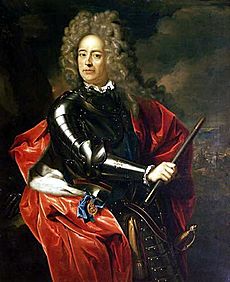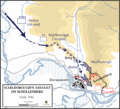Battle of Blenheim facts for kids
Quick facts for kids Battle of Blenheim |
|||||||
|---|---|---|---|---|---|---|---|
| Part of the War of the Spanish Succession | |||||||
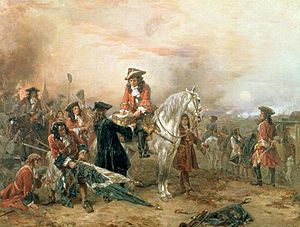 Duke of Marlborough signing the Despatch at Blenheim |
|||||||
|
|||||||
| Belligerents | |||||||
| Commanders and leaders | |||||||
|
|||||||
| Strength | |||||||
|
|
||||||
| Casualties and losses | |||||||
|
|
||||||
The Battle of Blenheim was a major battle during the War of the Spanish Succession. It took place on August 13, 1704, near the village of Blindheim (known as Blenheim in English) in Bavaria, Germany. This battle was a huge win for the Grand Alliance, a group of countries fighting against France and its allies.
The victory at Blenheim was super important. It kept the French and Bavarian armies from capturing Vienna, the capital of the Habsburg Empire. If Vienna had fallen, the Grand Alliance might have collapsed. This battle changed the direction of the war, which had been going well for France. It stopped France's plans to take the Holy Roman Emperor out of the war.
The French army suffered massive losses, and their main commander, Duke of Tallard, was even captured. After Blenheim, the Allies continued to win, taking more towns and fortresses. The war went on for another ten years, but Blenheim was a turning point.
Contents
Why the Battle of Blenheim Happened
What Caused the War?
The War of the Spanish Succession began in 1701. It was fought because European powers disagreed over who should inherit the Spanish throne. King Louis XIV of France wanted his grandson to become King of Spain. Other countries, like England, the Dutch Republic, and Austria, feared that this would make France too powerful. They formed the Grand Alliance to stop France from dominating Europe.
France's Plan to Win the War
By 1704, France and its allies were doing well, especially in the Danube region. King Louis XIV wanted to force the Holy Roman Emperor, Leopold, out of the war. His plan was to capture Vienna, the capital of the Habsburg Empire. If Vienna fell, the Grand Alliance would likely break apart.
There were several threats to Vienna:
- Forces from Bavaria and Marshal Ferdinand de Marsin were attacking from the west.
- A large French army in Italy, led by Marshal Louis Joseph de Bourbon, duc de Vendôme, could attack through the Brenner Pass.
- A Hungarian revolt, led by Francis II Rákóczi, was threatening from the east.
Marlborough's Secret March
The Duke of Marlborough, a brilliant British general, realized how much danger Vienna was in. He decided to march his army all the way from the Low Countries (modern-day Belgium and Netherlands) to help the Emperor. This was a very risky and secret plan.
Marlborough had to trick both his enemies and even some of his allies. The Dutch, for example, didn't want their troops to leave the Low Countries unprotected. So, Marlborough pretended he was going to attack along the Moselle River. But once he was on the move, he secretly turned south towards the River Danube.
- Marlborough marched about 400 kilometers (250 miles) in just five weeks.
- His army moved quickly and efficiently, surprising everyone.
- This amazing march is still studied today as a great example of military planning.
Getting Ready for Battle
Securing the Danube River
After reaching the Danube, Marlborough's first goal was to capture Donauwörth. This town was important because it had a good crossing point over the Danube. On July 2, the Allies stormed the fortress of Schellenberg near Donauwörth. It was a tough fight with many casualties, but the Allies won. This forced Donauwörth to surrender.
With Donauwörth secured, Marlborough wanted to fight the combined Bavarian and French army before they could get more troops. However, the enemy commanders, Maximilian and Marsin, avoided battle. They waited for Marshal Camille d'Hostun, duc de Tallard to arrive with reinforcements.
Joining Forces
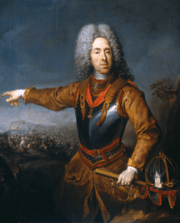
While Tallard was on his way, Prince Eugene of Savoy, another great Allied general, arrived with his own army to help Marlborough. The two generals met and planned their next moves. They decided that Prince Eugene would keep an eye on the French forces on the Rhine River, while Marlborough and Prince Louis of Baden would combine their armies and march towards the Danube.
Tallard's march was slow because his troops were tired and his supply wagons struggled through the Black Forest. Local German farmers, angry at the French, also attacked their supply lines. Finally, Tallard joined Maximilian and Marsin's forces near Augsburg on August 5.
Marlborough tried to force Maximilian to fight by burning crops and buildings in Bavaria. This was a harsh tactic, but it was meant to pressure the enemy and prevent them from using Bavaria as a base.
Final Positions Before Battle
By August 12, the French and Bavarian armies were camped behind a small river called the Nebel, near the village of Blindheim (Blenheim). Their position was strong, with the Danube River on one side and hills on the other. The ground around the Nebel was marshy, making it hard to cross.
Marlborough and Prince Eugene studied the French position. They decided to attack despite the enemy's strong defenses and larger numbers. Some Allied officers were worried, but Marlborough was determined to fight. He knew that a Dutch officer, Willem Vleertman, had scouted the marshy ground and reported it was suitable for troops.
- The French and Bavarian army had about 56,000 men and 90 cannons.
- The Grand Alliance army had about 52,000 men and 66 cannons.
The Battle of Blenheim Begins
Allied Attack Plan
On August 13, at 2:00 AM, the Allied army began to move. They marched quietly towards Blenheim. Marlborough and Prince Eugene made their final plans:
- Marlborough would lead 36,000 troops to attack Tallard's 33,000 men on the left, focusing on capturing Blenheim village.
- Prince Eugene would lead 16,000 men to attack Maximilian and Marsin's 23,000 troops on the right, near Lutzingen.
- The idea was to keep the French flanks busy so Marlborough could cross the Nebel River in the center and deliver a decisive blow.
The French commanders were not expecting an attack. They thought the Allies were retreating. They quickly got their troops ready for battle.
Fighting at Blenheim Village
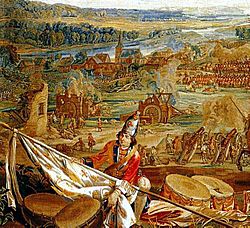
Around 1:00 PM, the Allied attack began. Lieutenant-General John Cutts led the assault on Blenheim village. The English infantry marched silently towards the village, facing heavy fire from French cannons. They tried to break through the defenses, but the French fired deadly volleys, pushing them back.
The French commander in Blenheim, Clérambault, made a big mistake. Without asking Tallard, he ordered more and more reserve battalions into the village. This crowded the French troops, making it hard for them to fight or even move. Marlborough saw this mistake and told Cutts to just keep the French trapped in the village, rather than trying to capture it completely. This meant about 5,000 Allied soldiers were able to hold down twice their number of French troops.
Struggles at Lutzingen
On the Allied right, Prince Eugene's forces faced a much tougher fight against Maximilian and Marsin. The Prussians and Danes attacked the strong French positions near Lutzingen. They faced heavy fire from cannons and infantry.
Prince Eugene's cavalry tried to cross the Nebel, but they were pushed back in confusion. Without cavalry support, the Prussian and Danish infantry also had to retreat. Some of Prince Eugene's troops panicked, but he bravely rallied them. He even shot two of his own troopers to stop them from fleeing, showing his determination.
The Allies attacked again, but they were still met with fierce resistance and were pushed back a second time. The fighting on this flank was very difficult and costly for the Allies.
Breaking Through the Center
While the flanks were busy, Marlborough prepared his main attack in the center. His troops crossed the Nebel River. Marlborough used a clever formation, placing his infantry battalions with gaps so his cavalry could move through them easily.
The French cavalry, led by Zurlauben, tried to stop the Allied advance. They charged bravely, but the Allied cavalry and infantry held firm. The French were surprised when their elite cavalry, the Gens d'Armes, were pushed back. Maximilian, the Bavarian commander, was shocked, exclaiming, "What? Is it possible? The gentlemen of France fleeing?"
Tallard, the French commander, realized the danger and asked Marsin for help. But Marsin refused, saying he was too busy fighting Prince Eugene. This was a critical moment. Tallard had few infantry battalions left in the center to face Marlborough's large force.
The Allied cavalry, supported by cannons and infantry, finally broke through the French center. Tallard's tired cavalry were routed. The remaining French infantry fought bravely, but they were overwhelmed and destroyed. Many French soldiers fled towards the Danube River, and over 3,000 drowned trying to escape.
Tallard himself was caught in the chaos and captured by Hessian troops. Marlborough greeted him, expressing sorrow for his misfortune.
The Fall of Blenheim Village
As the French center collapsed, Marlborough turned his attention back to Blenheim village. Allied infantry attacked the village from all sides. The fighting was fierce, with hand-to-hand combat. Many cottages caught fire, making the battle even more chaotic.
The French infantry in Blenheim fought hard, but their commander, Clérambault, was nowhere to be found. The Allied general, the Earl of Orkney, realized the French were trapped. He offered them a chance to surrender. Around 9:00 PM, about 10,000 of France's best infantry laid down their arms.
Marlborough, still on horseback, quickly wrote a note to his wife, Sarah, on the back of a tavern bill: "I have no time to say more but to beg you will give my duty to the Queen, and let her know her army has had a glorious victory."
Aftermath of the Battle
The Battle of Blenheim was a huge disaster for France. They lost over 27,000 soldiers killed, wounded, or captured. The idea that the French army was unbeatable was shattered. King Louis XIV's hopes for a quick and easy peace were gone.
- Marlborough and Prince Eugene had saved the Habsburg Empire and kept the Grand Alliance together.
- Many Bavarian towns and territories soon fell to the Allies.
- Bavaria was placed under Austrian military rule, which helped the Allies use its resources for the rest of the war.
Tallard, the captured French commander, was taken to England and held prisoner until 1711. Maximilian, the Elector of Bavaria, fled his country and continued to fight the Allies from the Spanish Netherlands.
Marlborough returned to England as a hero. Queen Anne rewarded him by granting him the Park of Woodstock and money to build a grand house, which became Blenheim Palace.
Historians consider Blenheim one of the most important battles in history. It prevented France from dominating Europe and changed the course of the War of the Spanish Succession.
Images for kids
-
Henry de Nassau, Lord Overkirk took control of Allied forces in the Netherlands
-
The Battle of Blenheim by John Wootton


